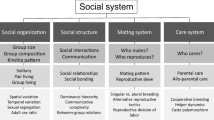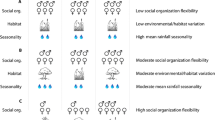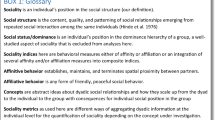Abstract
Social complexity can have important evolutionary implications, and phylogenetic comparative methods have long been used as a way to assess interspecific support for hypotheses on the subject. Statistical approaches for conducting such analyses have come a long way in the last few decades, and it is now possible to use comparative data to ask sophisticated questions about the evolution of complex phenotypes while taking also uncertainty in the phylogeny into account. Here, we illustrate these advances by applying a phylogenetic analysis of covariance to two data sets addressing the evolution of social complexity in primates. First, we find that social complexity (as inferred by group size) is predicted by whether a species is diurnal and terrestrial. Second, we find that social complexity (as inferred by social organization) has increased over evolutionary time and can impact trait evolution. Particularly, we find that baculum length has been growing with body size in dispersed, pair-living and, more weakly, multi-male species, becoming relatively smaller and more variable in aggregations that are more socially stable.
Significance statement
Sociality poses a particular challenge for interspecific analyses because of the many ways that its intrinsic complexity can be coded into statistical variables and models. However, with methods that incorporate phylogenies and nuanced inferences about underlying evolutionary processes, even coarse measures of social complexity can offer valuable insights in the study of behavioral trends through time. Exploring two interspecific data sets on primates, we show how simple measures of sociality, either coded as continuous or categorical variables, can be used to revisit latent evolutionary hypotheses while revealing new pieces of information that become available thanks to the added complexity of novel phylogenetic comparative methods. One example reveals that larger and more variable groups are associated with shifts in habitat and activity patterns, while the other reveals that baculum evolution might be influenced by the increasing social stability of primate aggregations.


Similar content being viewed by others
References
Arnold C, Matthews LJ, Nunn CL (2010) The 10kTrees website: a new online resource for primate phylogeny. Evol Anthropol 19:114–118
Baker J, Meade A, Pagel M, Venditti C (2015) Adaptive evolution toward larger size in mammals. Proc Natl Acad Sci 112(16):5093–5098
Barton RA (1993) Independent contrasts analysis of neocortical size and socioecology in primates. Behav Brain Sci 16:694–695
Barton RA, Venditti C (2014) Rapid evolution of the cerebellum in humans and other great apes. Curr Biol 24:2440–2444
Bartoszek K, Pienaar J, Mostad P, Andersson S, Hansen TF (2012) A phylogenetic comparative method for studying multivariate adaptation. J Theor Biol 314:204–215
Beaulieu JM, Jhwueng D-C, Boettiger C, O’Meara BC (2012) Modeling stablizing selection: expanding the Ornstein-Uhlenbeck model of adaptive evolution. Evolution 66:2369–2383
Beshers SN, Fewell JH (2001) Models of division of labor in social insects. Annu Rev Entomol 46:413–440
Blomberg SP, Lefevre JG, Wells JA, Waterhouse M (2012) Independent contrasts and PGLS regression estimators are equivalent. Syst Biol 61:382–391
Bollback J (2006) SIMMAP: stochastic character mapping of discrete traits on phylogenies. BMC Bioinformatics 7(88):88
Brindle M, Opie C (2016) Postcopulatory sexual selection influences baculum evolution in primates and carnivores. Proc R Soc B 283:20161736
Butler MA, Schoener TW, Losos JB (2000) The relationship between sexual size dimorphism and habitat use in greater Antillean Anolis lizards. Evolution 54:259–272
Cheverud JM, Dow MM, Leutenegger W (1985) The quantitative assessment of phylogenetic constraints in comparative analyses: sexual dimorphism in body weight among primates. Evolution 39:1335–1351
Danforth BN (2002) Evolution of sociality in a primitively eusocial lineage of bees. Proc Natl Acad Sci U S A 99:286–290
de Villemereuil P, Wells JA, Edwards RD, Blomberg SP (2012) Bayesian models for comparative analysis integrating phylogenetic uncertainty. BMC Evol Biol 12:102
Dixson A (1987a) Baculum length and copulatory behavior in primates. Am J Primat 13:51–60
Dixson A (1987b) Observations on the evolution of the genitalia and copulatory behaviour in male primates. J Zool 213:423–443
Dixson AF (1995) Baculum length and copulatory behaviour in carnivores and pinnipeds (grand order ferae). J Zool 235:67–76
Dixson AF (2013) Primate sexuality: comparative studies of the prosimians, monkeys, apes and humans. Oxford University Press, Oxford
Dixson AF, Anderson MJ (2004) Sexual behavior, reproductive physiology and sperm competition in male mammals. Physiol Behav 83:361–371
Dixson A, Nyholt J, Anderson M (2004) A positive relationship between baculum length and prolonged intromission patterns in mammals. Dong Wu Xue Bao 50:490–503
Dixson A, Dixson B, Anderson M (2005) Sexual selection and the evolution of visually conspicuous sexually dimorphic traits in male monkeys, apes, and human beings. Annu Rev Sex Res 16:1–19
Dunbar RIM (1993) Coevolution of neocortical size, group size and language in humans. Behav Brain Sci 16:681–694
Eastman JM, Alfaro ME, Joyce P, Hipp AL, Harmon LJ (2011) A novel comparative method for identifying shifts in the rate of character evolution on trees. Evolution 65:3578–3589
Eberhard WG (1985) Sexual selection and animal genitalia. Harvard University Press, Cambridge
Felsenstein J (1985) Phylogenies and the comparative method. Am Nat 125:1–15
Fitzpatrick JL, Almbro M, González-Voyer A, Kolm N, Simmons LW (2012) Male contest competition and the coevolution of weaponry and testes in pinnipeds. Evolution 66:3595–3604
Freckleton RP, Harvey PH, Pagel M (2002) Phylogenetic analysis and comparative data: a test and review of evidence. Am Nat 160:712–726
Fuentes-González JA (2018) Phylogenies and the comparative method in morphometrics: a behavioral glimpse on morphological evolution. PhD dissertation, Indiana University, Bloomington, IN
Fuentes-González JA, Muñoz-Durán J (2017) Comportamiento social y preferencias alimentarias en la evolución de los cánidos actuales. Rev Mex Biodivers 88:192–206
Fuentes-González JA, Housworth EA, Weber A, Martins EP (2016) Phylogenetic ANCOVA: estimating phenotypic diversification and evolutionary relationships in comparative studies. Am Nat 188:615–627
Ganzhorn JU, Abraham JP, Razanahoera-Rakotomalala M (1985) Some aspects of the natural history and food selection of Avahi laniger. Primates 26:452–463
Garamszegi LZ (2014) Modern phylogenetic comparative methods and their application in evolutionary biology: concepts and practice. Springer-Verlag, Berlin
Garland T, Dickerman AW, Janis CM, Jones JA (1993) Phylogenetic analysis of covariance by computer simulation. Syst Biol 42:265–292
Gelman A (2006) Prior distributions for variance parameters in hierarchical models. Bayesian Anal 1:515–534
Gonzalez-Voyer A, von Hardenberg A (2014) An introduction to phylogenetic path analysis. In: Garamszegi LZ (ed) Modern phylogenetic comparative methods and their application in evolutionary biology: concepts and practice. Springer, Berlin, pp 201–229
Gonzalez-Voyer A, Winberg S, Kolm N (2009) Social fishes and single mothers: brain evolution in African cichlids. Proc R Soc Lond B 276:161–167
Hadfield JD, Nakagawa S (2010) General quantitative genetic methods for comparative biology: phylogenies, taxonomies and multi-trait models for continuous and categorical characters. J Evol Biol 23:494–508
Hansen TF (1997) Stabilizing selection and the comparative analysis of adaptation. Evolution 51:1341–1351
Hansen TF (2014) Use and misuse of comparative methods in the study of adaptation. In: Garamszegi LZ (ed) Modern phylogenetic comparative methods and their application in evolutionary biology. Springer-Verlag, Berlin, pp 351–379
Hansen TF, Pienaar J, Orzack SH (2008) A comparative method for studying adaptation to a randomly evolving environment. Evolution 62:1965–1977
Harcourt AH, Harvey PH, Larson SG, Short RV (1981) Testis weight, body weight and breeding system in primates. Nature 293:55–57
Heidelberger P, Welch PD (1981) A spectral method for confidence interval generation and run length control in simulations. Commun ACM 24:233–245
Heidelberger P, Welch PD (1983) Simulation run length control in the presence of an initial transient. Oper Res 31:1109–1144
Henshaw JM, Kahn AT, Fritzsche K (2016) A rigorous comparison of sexual selection indexes via simulations of diverse mating systems. Proc Natl Acad Sci U S A 113:E300–E308
Hoff PD (2009) First course in Bayesian statistical methods. Springer, New York
Housworth EA, Martins EP, Lynch M (2004) The phylogenetic mixed model. Am Nat 163:84–96
Huelsenbeck JP, Rannala B (2003) Detecting correlation between characters in a comparative analysis with uncertain phylogeny. Evolution 57(6):1237–1247
Huelsenbeck JP, Nielsen R, Bollback JP (2003) Stochastic mapping of morphological characters. Syst Biol 52:131–158
Hutcheon JM, Kirsch JA, Garland T (2002) A comparative analysis of brain size in relation to foraging ecology and phylogeny in the Chiroptera. Brain Behav Evol 60:165–180
Jones AG (2009) On the opportunity for sexual selection, the Bateman gradient and the maximum intensity of sexual selection. Evolution 63:1673–1684
Kamagi DDW, Corebima AD, Rengkuan M (2014) Phylogenetic position of North Sulawesi Tarsius sp. based on partial cytochrome b gene sequences. Open J Genet 4:10
Kocher SD, Paxton RJ (2014) Comparative methods offer powerful insights into social evolution in bees. Apidologie 45:289–305
Kruschke JK, Liddell TM (2018) The Bayesian new statistics: hypothesis testing, estimation, meta-analysis, and power analysis from a Bayesian perspective. Psychon Bull Rev 25:178–206
Kverková K, Bělíková T, Olkowicz S, Pavelková Z, O’Riain MJ, Šumbera R, Burda H, Bennett NC, Němec P (2018) Sociality does not drive the evolution of large brains in eusocial African mole-rats. Sci Rep 8:9203
Larivière S, Ferguson SH (2002) On the evolution of the mammalian baculum: vaginal friction, prolonged intromission or induced ovulation? Mammal Rev 32:283–294
Lavin SR, Karasov WH, Ives AR, Middleton KM, Garland T Jr (2008) Morphometrics of the avian small intestine compared with that of nonflying mammals: a phylogenetic approach. Physiol Biochem Zool 81:526–550
Lawing AM, Polly PD, Hews DK, Martins EP (2016) Including fossils in phylogenetic climate reconstructions: a deep time perspective on the climatic niche evolution and diversification of spiny lizards (Sceloporus). Am Nat 188:133–148
Lewis PO (2001) A likelihood approach to estimating phylogeny from discrete morphological character data. Syst Biol 50:913–925
Link WA, Eaton MJ (2012) On thinning of chains in MCMC. Methods Ecol Evol 3:112–115
Lynch M (1991) Methods for the analysis of comparative data in evolutionary biology. Evolution 45:1065–1080
MacLean EL, Matthews LJ, Hare BA et al (2012) How does cognition evolve? Phylogenetic comparative psychology. Anim Cogn 15:223–238
Maddison WP, Maddison DR (2011) Mesquite: a modular system for evolutionary analysis. version 2.74. http://mesquiteproject.org. Accessed 24 March 2017
Martins EP, Fuentes-González JA (2018) Comparative methods and phylogenetic tests of adaptation. In: Pfennig K (ed) Oxford bibliographies in evolutionary biology. Oxford University Press, New York, pp 1–19
Nielsen R (2002) Mapping mutations on phylogenies. Syst Biol 51:729–739
Nunn CL, Barton RA (2000) Allometric slopes and independent contrasts: a comparative test of Kleiber’s law in primate ranging patterns. Am Nat 156:519–533
Nunn CL, Barton RA (2001) Comparative methods for studying primate adaptation and allometry. Evol Anthropol 10:81–98
Nunn CL, van Schaik CP (2002) A comparative approach to reconstructing the socioecology of extinct primates. In: Plavcan JM, Kay RF, Jungers WL, van Schaik CP (eds) Reconstructing behavior in the primate fossil record. Springer, Boston, pp 159–215
O'Meara BC (2012) Evolutionary inferences from phylogenies: a review of methods. Annu Rev Ecol Syst 43:267–285
O'Meara BC, Ané C, Sanderson MJ, Wainwright PC (2006) Testing for different rates of continuous trait evolution using likelihood. Evolution 60:922–933
Opie C, Atkinson QD, Shultz S (2012) The evolutionary history of primate mating systems. Commun Integr Biol 5:458–461
Orr TJ, Brennan PLR (2016) All features great and small—the potential roles of the baculum and penile spines in mammals. Integr Comp Biol 56:635–643
Pagel MD (1999) Inferring the historical patterns of biological evolution. Nature 401:877–884
Pagel MD, Meade A (2006) Bayesian analysis of correlated evolution of discrete characters by reversible-jump Markov chain Monte Carlo. Am Nat 167:808–825
Pellis SM, Iwaniuk AN (1999) The roles of phylogeny and sociality in the evolution of social play in muroid rodents. Anim Behav 58:361–373
Pennell MW, Harmon LJ (2013) An integrative view of phylogenetic comparative methods: connections to population genetics, community ecology, and paleobiology. Ann N Y Acad Sci 1289:90–105
Pérez-Barbería FJ, Shultz S, Dunbar RIM (2007) Evidence for coevolution of sociality and relative brain size in three order of mammals. Evolution 61:2811–2821
Plummer M (2003) JAGS: a program for analysis of Bayesian graphical models using Gibbs sampling. In: Proceedings of the 3rd international workshop on distributed statistical computing. Vienna, p 125
Plummer M (2016) rjags: Bayesian Graphical Models using MCMC. Version 4–6. https://CRAN.R-project.org/package=rjags. Accessed 4 April 2017
Plummer M, Best N, Cowles K, Vines K (2006) CODA: convergence diagnosis and output analysis for MCMC. R News 6:7–11
R Development Core Team (2016) R: a language and environment for statistical computing, version 3.3.2. R Foundation for Statistical Computing, Vienna, http://www.R-project.org. Accessed 1 February 2018
Ramm SA (2007) Sexual selection and genital evolution in mammals: a phylogenetic analysis of baculum length. Am Nat 169:360–369
Revell LJ (2009) Size-correction and principal components for interspecific comparative studies. Evolution 63:3258–3268
Revell LJ (2012) Phytools: an R package for phylogenetic comparative biology (and other things). Methods Ecol Evol 3:217–223
Revell LJ, Graham Reynolds R (2012) A new Bayesian method for fitting evolutionary models to comparative data with intraspecific variation. Evolution 66:2697–2707
Revell LJ, Mahler DL, Peres-Neto PR, Redelings BD (2012) A new phylogenetic method for identifying exceptional phenotypic diversification. Evolution 66:135–146
Rohlf FJ (2006) A comment on phylogenetic correction. Evolution 60:1509–1515
Ronquist F (2004) Bayesian inference of character evolution. Trends Ecol Evol 19:475–481
Schultz TR, Churchill GA (1999) The role of subjectivity in reconstructing ancestral character states: a Bayesian approach to unknown rates, states, and transformation asymmetries. Syst Biol 48:651–664
Schultz NG, Lough-Stevens M, Abreu E, Orr T, Dean MD (2016) The baculum was gained and lost multiple times during mammalian evolution. Integr Comp Biol 56:644–656
Shultz S, Dunbar RIM (2006) Both social and ecological factors predict ungulate brain size. Proc R Soc Lond B 273:207–215
Shultz S, Dunbar RI (2010) Social bonds in birds are associated with brain size and contingent on the correlated evolution of life-history and increased parental investment. Biol J Linn Soc 100:111–123
Shultz S, Opie C, Atkinson QD (2011) Stepwise evolution of stable sociality in primates. Nature 479:219–222
Shuster SM, Wade MJ (2003) Mating systems and strategies. Princeton University Press, Princeton
Smith RJ, Jungers WL (1997) Body mass in comparative primatology. J Hum Evol 32:523–559
Snow G (2016) Teaching demos: demonstrations for teaching and learning, version 2.10. http://CRAN.R-project.org/package=TeachingDemos. Accessed 1 February 2018
Steel PD, Kammeyer-Mueller J (2008) Bayesian variance estimation for meta-analysis: quantifying our uncertainty. Organ Res Methods 11:54–78
Stockley P (2002) Sperm competition risk and male genital anatomy: comparative evidence for reduced duration of female sexual receptivity in primates with penile spines. Evol Ecol 16:123–137
Sumpter D, Buhl J, Biro D, Couzin I (2008) Information transfer in moving animal groups. Theory Biosci 127:177–186
Terborgh J, Janson CH (1986) The socioecology of primate groups. Annu Rev Ecol Evol Syst 17(1):111–136
Thomas GH, Freckleton RP, Székely T (2006) Comparative analyses of the influence of developmental mode on phenotypic diversification rates in shorebirds. Proc R Soc Lond B 273:1619–1624
Thomas GH, Meiri S, Phillimore AB (2009) Body size diversification in Anolis: novel environment and island effects. Evolution 63:2017–2030
Venables WN, Ripley BD (2002) Modern applied statistics with S, 4th edn. Springer, New York
Verrell PA (1992) Primate penile morphologies and social systems: further evidence for an association. Folia Primatol 59:114–120
von Hardenberg A, Gonzalez-Voyer A (2013) Disentangling evolutionary cause-effect relationships with phylogenetic confirmatory path analysis. Evolution 67:378–387
von Koenigswald W (1979) Ein Lemurenrest aus dem eozänen Ölschiefer der Grube Messel bei Darmstadt. Palaeontol Z 53:63–76
West HE, Capellini I (2016) Male care and life history traits in mammals. Nat Commun 7:11854
Acknowledgments
The authors wish to thank the editors and two anonymous reviewers for detailed and helpful comments provided on earlier versions of this manuscript.
Funding
This material is based upon work supported by the National Science Foundation under grant number IOS-1257562 to EPM. It was also supported by fellowships from COLCIENCIAS (Becas Caldas 497-2009) and the Center for the Integrative Study of Animal Behavior (CISAB) at Indiana University to JAF-G.
Author information
Authors and Affiliations
Corresponding author
Ethics declarations
Conflict of interest
The authors declare that they have no conflict of interest.
Ethical approval
This article does not contain any studies with human participants or animals performed by any of the authors.
Additional information
Communicated by S. Shultz
Publisher’s Note
Springer Nature remains neutral with regard to jurisdictional claims in published maps and institutional affiliations.
This article is a contribution to the Topical Collection Social complexity: patterns, processes, and evolution - Guest Editors: Peter Kappeler, Susanne Shultz, Tim Clutton-Brock, and Dieter Lukas
Electronic supplementary material
ESM 1
(DOCX 1611 kb)
Rights and permissions
About this article
Cite this article
Fuentes-González, J.A., Martins, E.P. Using phylogenetic comparative methods to gain insight into the evolution of social complexity. Behav Ecol Sociobiol 73, 3 (2019). https://doi.org/10.1007/s00265-018-2614-3
Received:
Revised:
Accepted:
Published:
DOI: https://doi.org/10.1007/s00265-018-2614-3




